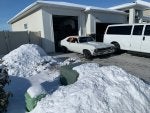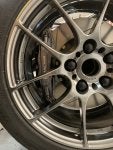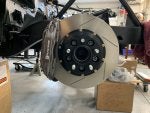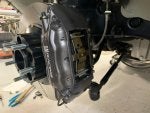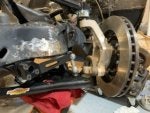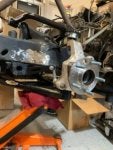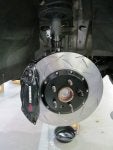I've been looking to upgrade my brakes on my 94 impala ss. Seen a couple different brands and I'm leaning towards the power stop z23 kit but I'd like to know everyone's input on it and what do you guys recommend.

Ep_904
Brake upgrade recommendations ??
Ep_904
Discussion starter
7 posts
·
Joined 2024
- Add to quote
I've been looking to upgrade my brakes on my 94 impala ss. Seen a couple different brands and I'm leaning towards the power stop z23 kit but I'd like to know everyone's input on it and what do you guys recommend.
3,877 posts
·
Joined 2000
How do you define "upgrade"?
All PowerStop rotors are slotted and/or drilled. The stock B-body rotor is mass-challenged already, and drilling a bunch of holes in it reduces the mass - that's the wrong direction, depending on how you view that word "upgrade". Slotted rotors are less of an issue, but not necessarily essential.
Rotor mass has to be considered, and unless you are willing to invest in LARGER (diameter) or THICKER rotors, and the added changes necessary to accomplish that, it's a bit of a crap shoot. New quality OE spec rotors and proper pads for the intended purpose of the car is the one option you have just using OE brake rotor dimensions.
All PowerStop rotors are slotted and/or drilled. The stock B-body rotor is mass-challenged already, and drilling a bunch of holes in it reduces the mass - that's the wrong direction, depending on how you view that word "upgrade". Slotted rotors are less of an issue, but not necessarily essential.
Rotor mass has to be considered, and unless you are willing to invest in LARGER (diameter) or THICKER rotors, and the added changes necessary to accomplish that, it's a bit of a crap shoot. New quality OE spec rotors and proper pads for the intended purpose of the car is the one option you have just using OE brake rotor dimensions.
2,908 posts
·
Joined 2005
Well, I mean, no.All PowerStop rotors are slotted and/or drilled
As far as drilled and slotted rotors, I think that’s a math equation that is over the head of almost everybody, especially me.
While a rotor with greater mass will take longer to overheat, it will also cool more slowly than the same rotor with holes drilled in it.
It seems reasonable to assume that holes and/or slots are going to cause the pads to “bite” or grab onto the rotor harder. But, that isn’t automatically a good thing.
The issue isn’t black and white.
47 posts
·
Joined 2017
Drilled and slotted might look cool, but if you plan to track they're not going to help much and probably make it worse.
Like Navy said, get a nice set of plain rotors and a quality pad (EBC, Hawk, etc...).
Or, you can go the route of full upgrade where you need to change multiple things out from OE.
Also if you haven't already, the brake bolt mod (searchable on the forum) is a a HUGE upgrade. Along with properly flushed fluid and some stainless steel lines makes a big positive change.
Like Navy said, get a nice set of plain rotors and a quality pad (EBC, Hawk, etc...).
Or, you can go the route of full upgrade where you need to change multiple things out from OE.
Also if you haven't already, the brake bolt mod (searchable on the forum) is a a HUGE upgrade. Along with properly flushed fluid and some stainless steel lines makes a big positive change.
499 posts
·
Joined 2002
I would say to upgrade to the infamous HD12 kit from Bill Harper, but we know that is no longer an option. I can attest to having quality rotors and racing. Use only the best rotors and pads.
For a stock rotor, get the EBC rotors.
And never, never, never, never get drilled rotors and use for racing unless you are willing to change rotors after each event.
YMMV
Michael
For a stock rotor, get the EBC rotors.
And never, never, never, never get drilled rotors and use for racing unless you are willing to change rotors after each event.
YMMV
Michael
3,877 posts
·
Joined 2000
You're killing me Michael...."infamous"???I would say to upgrade to the infamous HD12 kit from Bill Harper, but we know that is no longer an option.
YMMV
Michael
You always were a standout proponent of HD12....sorry that it was not able to continue, but it certainly proved it's value over the time it was available, and plenty of them are still out there in service. It would have taken a major financial commitment to produce more of the same or a re-imagined one-piece rotor built around the KORE3 HD GMTS hub. I was not prepared to do that.
Plenty of options today, but few, if any, that were as simple & clean as HD12.
8,092 posts
·
Joined 2001
OP, previous responses pretty much spell it out.
A "noticeable" improvement is going with stainless steel braided brake lines and stealth bolt. The SS lines do not expand like the rubber ones providing a firmer brake pedal feel and the stealth mod corrects the 95/5 disc/drum proportioning valve to a 70/30 disc/disc type which keeps the car flatter (read less/no nosedive when braking).
Drilled and or slotted rotors...well given the small size of stock rotors the line gets thin on losing mass as a result of holes and or slots that provide greater heat and dust dissipation and improved, or not, braking performance. Have not seen A&B tests (drilled/slotted vs full disc rotors) on the SS but FWIW any high-performance car (Ferrari, Porsch or whatever) has drilled rotors and huge calipers but on MUCH larger rotors. Point is drilled and slotted rotors do have a positive function, but the SIZE of rotor is a major factor also.
Using a quality, more aggressive pad on whatever rotor and caliper setup you have provides better braking
A "noticeable" improvement is going with stainless steel braided brake lines and stealth bolt. The SS lines do not expand like the rubber ones providing a firmer brake pedal feel and the stealth mod corrects the 95/5 disc/drum proportioning valve to a 70/30 disc/disc type which keeps the car flatter (read less/no nosedive when braking).
Drilled and or slotted rotors...well given the small size of stock rotors the line gets thin on losing mass as a result of holes and or slots that provide greater heat and dust dissipation and improved, or not, braking performance. Have not seen A&B tests (drilled/slotted vs full disc rotors) on the SS but FWIW any high-performance car (Ferrari, Porsch or whatever) has drilled rotors and huge calipers but on MUCH larger rotors. Point is drilled and slotted rotors do have a positive function, but the SIZE of rotor is a major factor also.
Using a quality, more aggressive pad on whatever rotor and caliper setup you have provides better braking
3,894 posts
·
Joined 2015
I've been looking to upgrade my brakes on my 94 impala ss.
Unless you are racing or driving in the mountains the best brake upgrade is better tires.How do you define "upgrade"?
These cars with quality stock parts will brake as hard or harder than modern vehicles.
To improve on stopping distance and brake fade due to heat you will need deep pockets.
Compare the Impala to modern super cars and they are still good.
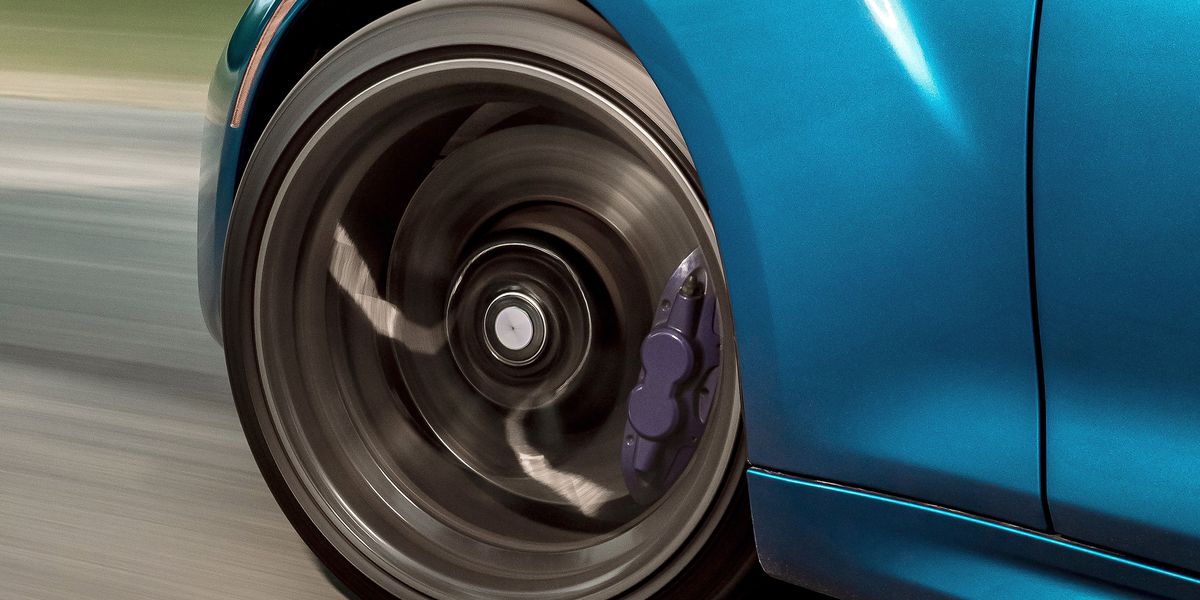
Best Brakes: The Shortest-Stopping Cars We've Ever Tested
An essential quality in a fast car is how quickly it can become a stopped car.
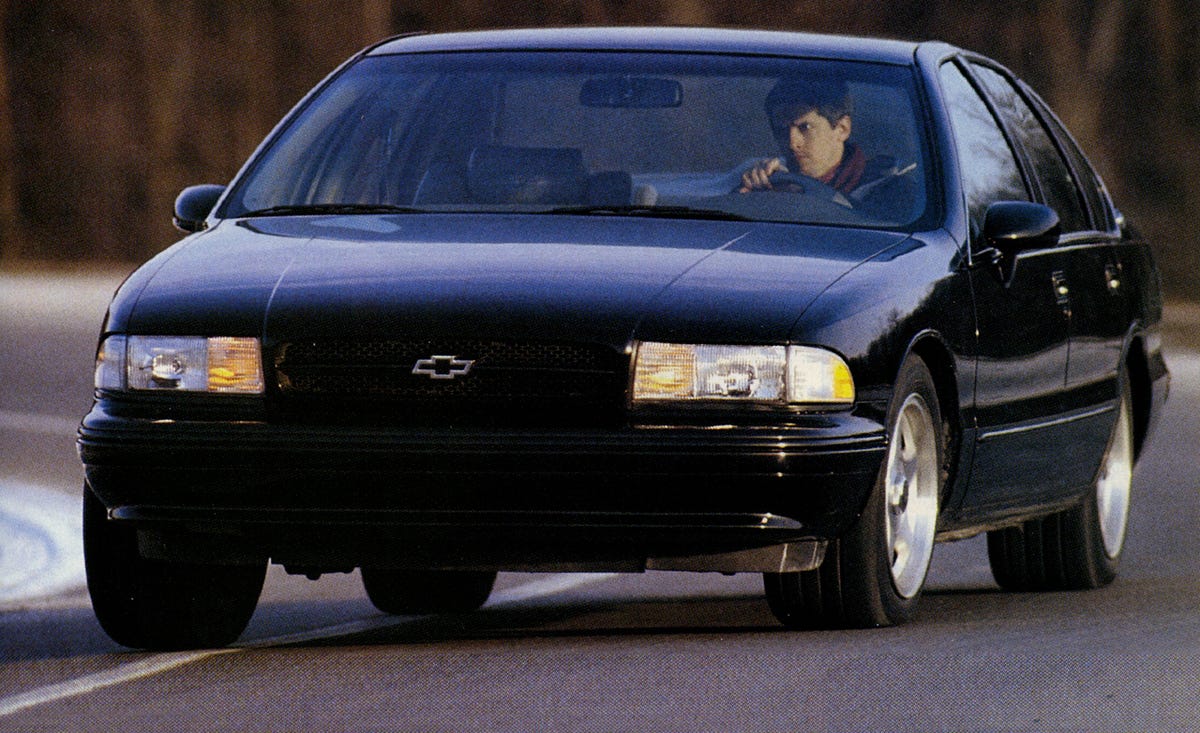
1994 Chevrolet Impala SS
It combines Sixties SS acceleration with Nineties braking and handling.
Michigan police tests have the 9C1 Caprice (same brakes as Impala) stopping within 10 feet of a Camaro.
Find the current tests and the Caprice is still close to modern choices.
In full Michigan tests the Caprice also beat most in the 90-0 tests and hot brake tests.
Here are some forum brake tests:

group G-tech brake stopping distance test!
I was wondering for thise of you who have g-techs if you would be interested in doing some testing as far as braking ability is concerned. I have one and would report now but it is wet. I think this would be a fun litte test to do. We could list braking times and the brake mods we have done and...
In this 1991 brake test a Roadmaster wagon (drum rear) towing a 1750Lb trailer (with out brakes) out braked all but one vehicle without a trailer. Page 39 "Getting Hitched"
Popular Mechanics
Popular Mechanics inspires, instructs and influences readers to help them master the modern world. Whether it’s practical DIY home-improvement tips, gadgets and digital technology, information on the newest cars or the latest breakthroughs in science -- PM is the ultimate guide to our high-tech...
books.google.ca
51 posts
·
Joined 2012
I've had the power stop KC4338 kit for about 6 - 7 months on my 96 imp and it is a huge improvement over the factory brakes. Comes with calipers, pads, and rotors. I also put the goodridge 12222 stainless brake line kit and i actually have brakes now haha. Stealth brake bolt mod helps too which i have on there. My old brakes in the front were always squeaking and had the wear indicator tabs adjusted several times over the years but the noise never went away completely. Now it's quiet and less dust on the rims too. I will add that the front rotors did get some surface rust after heavy rains in the winter but the rears still look new.
726 posts
·
Joined 2000
Glad to see you're still around Bill, hit me up if you make a trip to SA!
3,877 posts
·
Joined 2000
Been a good while, and would really enjoy that! Focus has been on Idaho where my 1970 Nova is in the able hands of my son, being brought back to life.
Nice C8 ya got there!
Still cruising along with the 9C3 PPV - 112K!
first start
Nice C8 ya got there!
Still cruising along with the 9C3 PPV - 112K!
first start
Attachments
-
595.6 KB Views: 29
3,266 posts
·
Joined 2008
Have you tried these? The hats are for 8x7 rotors. And those rotors are 8x7.05.The HD12 kit isn't dead, you can still build it using Wilwood components. The part numbers are:
Aluminum hats: 170-0764 (need 2 of them)
Right rotor: 160-16027 (need 1)
Left rotor: 160-16028 (need 1)
These are not what you show in the pictures. They look like 12 bolt rotors. Guessing those are original HD12?
894 posts
·
Joined 2020
And just to contribute to some of the info in this thread;
The front brakes on these cars are pretty darn good. With the right pads, you can lock up the wheels every time. Brakes literally can't do any better than that. Larger diameter brakes will only lock up the wheels sooner, which means less potential for modulation. The big issue with our brakes is capacity, they heat up pretty quick and start to fade after just a couple of really hard stops. Then that heat migrates to the built-in hubs and cooks the bearings. Switching to 1.25" rotors with aluminum hats on billet aluminum hubs pretty much solves that problem, AND it doesn't reduce the modulation range. It's a much better solution than large diameter brakes, especially for the street, and even for autoX-ing. My local parts stores either have J55 calipers readily in stock for dirt cheap, or can get them within a day. And D52 pads are EVERYWHERE in EVERY possible compound.
The front brakes on these cars are pretty darn good. With the right pads, you can lock up the wheels every time. Brakes literally can't do any better than that. Larger diameter brakes will only lock up the wheels sooner, which means less potential for modulation. The big issue with our brakes is capacity, they heat up pretty quick and start to fade after just a couple of really hard stops. Then that heat migrates to the built-in hubs and cooks the bearings. Switching to 1.25" rotors with aluminum hats on billet aluminum hubs pretty much solves that problem, AND it doesn't reduce the modulation range. It's a much better solution than large diameter brakes, especially for the street, and even for autoX-ing. My local parts stores either have J55 calipers readily in stock for dirt cheap, or can get them within a day. And D52 pads are EVERYWHERE in EVERY possible compound.
2,431 posts
·
Joined 2019
Aesthetically tho big pie brakes behind the wheels look 😍
![Image]()
But I agree with the sentiment of:
Stock blank rotors, good pads. Fresh fluid, lines and calipers (if they need to be refreshed)
But I agree with the sentiment of:
Stock blank rotors, good pads. Fresh fluid, lines and calipers (if they need to be refreshed)
894 posts
·
Joined 2020
I guess it depends on what you're prioritizing. You're right, big brakes that fill up the wheels look more impressive. And they work fine, too. There's nothing unsafe about them.
But I'm more of a function-over-form guy. Having excellent, fade-free brake performance using readily-available service parts with more control is mighty appealing. And those Wilwood dual-piston D52 calipers still manage to look pretty sweet for those that opt for them.
Ultimately, brakes are heatsinks to absorb the kinetic energy of the vehicle. I'm more interested in the ones that provide the most control (speed check to wheel lock) predictably (no brake fade) within a reasonable range of leg effort (60 pounds max is nice) in the application I'm looking for (street/autoX). This setup has worked best for me:
![Image]()
![Image]()
But I'm more of a function-over-form guy. Having excellent, fade-free brake performance using readily-available service parts with more control is mighty appealing. And those Wilwood dual-piston D52 calipers still manage to look pretty sweet for those that opt for them.
Ultimately, brakes are heatsinks to absorb the kinetic energy of the vehicle. I'm more interested in the ones that provide the most control (speed check to wheel lock) predictably (no brake fade) within a reasonable range of leg effort (60 pounds max is nice) in the application I'm looking for (street/autoX). This setup has worked best for me:


894 posts
·
Joined 2020
Same setup with a Wilwood dual piston D52 caliper (also available in red and black):
![Image]()

894 posts
·
Joined 2020
Drilled holes do not help except in very specific circumstances. The main thing they do is reduce rotor mass and create starting points for cracks. They look "pretty", but they're only admired by people who don't know any better. They do not add "bite" for the pads, but they do reduce the amount of surface area available to transfer heat from the rotors to the pads. In 99% of cases, drilled holes are a detriment. If we replaced a drilled rotor with a plain one that had enough internal mass removed to weigh exactly the same, the braking performance would be either exactly the same or better, with less chance of cracking.
Slots are different. They're typically cast into the surface of the rotor rather than machined, and they don't go all the way through, so they don't really contribute to potential cracking. They only marginally reduce mass, so the rotors retain their heat capacity. They barely reduce surface area, so heat transfer to/from the pads still occurs at about the same rate as plain rotors. They still allow any outgassing of the pads to escape (if that's ever an issue, which it never will be on the street). They help prevent debris from getting stuck on the surface of the pads, thereby potentially avoiding grooving of the rotors. Pound for pound, ounce for ounce, most slotted rotors provide an added benefit over plain rotors, though not one that's necessarily worth the added cost for a street application.
In no cases do drilled holes or slots provide any added stopping power from a perceived "bite" into the pads, even if you might feel those features through the brake pedal. Stopping power is purely a function of the coefficient of friction of the pad (which varies based on the pad's temperature and compound), how hard it's being pressed against the rotors, and what leverage advantage the pads have against the rotor.
Slots are different. They're typically cast into the surface of the rotor rather than machined, and they don't go all the way through, so they don't really contribute to potential cracking. They only marginally reduce mass, so the rotors retain their heat capacity. They barely reduce surface area, so heat transfer to/from the pads still occurs at about the same rate as plain rotors. They still allow any outgassing of the pads to escape (if that's ever an issue, which it never will be on the street). They help prevent debris from getting stuck on the surface of the pads, thereby potentially avoiding grooving of the rotors. Pound for pound, ounce for ounce, most slotted rotors provide an added benefit over plain rotors, though not one that's necessarily worth the added cost for a street application.
In no cases do drilled holes or slots provide any added stopping power from a perceived "bite" into the pads, even if you might feel those features through the brake pedal. Stopping power is purely a function of the coefficient of friction of the pad (which varies based on the pad's temperature and compound), how hard it's being pressed against the rotors, and what leverage advantage the pads have against the rotor.
2,908 posts
·
Joined 2005
The point of the brake pads is to stop the rotor from moving, right?In no cases do drilled holes or slots provide any added stopping power from a perceived "bite" into the pads, even if you might feel those features through the brake pedal. Stopping power is purely a function of the coefficient of friction of the pad (which varies based on the pad's temperature and compound), how hard it's being pressed against the rotors, and what leverage advantage the pads have against the rotor.
You're saying in a single braking event, that holes and/or slots don't give the pads more to grab on to?
3,894 posts
·
Joined 2015
NASCAR still uses steel rotors. Slotted but not drilled.
Indy car and formula 1 are carbon but they do not drill either.
In all cases the slot is shallow and small.
Post your best pad choices as there are bad ones (usually cheap).
Indy car and formula 1 are carbon but they do not drill either.
In all cases the slot is shallow and small.
Post your best pad choices as there are bad ones (usually cheap).
894 posts
·
Joined 2020
Post your best pad choices as there are bad ones (usually cheap).
Performance Friction pads (typical Rockauto fare) are decent. They never squeal, they don't dust much, they'll lock up the wheels given enough pedal pressure. They're glued to the backing plates (meh). I ran those for years with good success.
Hawk SD pads have fantastic initial bite, and they'll lock up the wheels anytime you want them to. They're typically intended for towing applications. They will squeal at times, and they dust a bit, so keeping the wheels clean is important. I never checked to see how the material is bonded to the backing plate. You can't really use them on Wilwood dual piston calipers because the rivets on the shims make contact with the edge of the pistons. I suppose one could just remove the shims.
Wilwood BP-20 are very similar in characteristic, but they dust a little more. They can handle more heat than the Hawk SD pads. They have a smooth backing plate that will work in single and dual piston calipers. They don't include any clips for use in single-piston (OEM) calipers, so they'll rattle a bit as they shift around inside the caliper while not applying the brakes. This isn't an issue as far as actual braking performance. The pads are glued to the backing plates, in addition to being molded into "teeth" that protrude from the backing plate. There's no risk of the pads separating from the backing plates. For performance applications, I'm a big fan.
I'd love to try Porterfield's R4-S compound, that may be what I try next. I've also heard great things about G-loc pads, though those are VERY expensive.
499 posts
·
Joined 2002
When I race my Impala, I use the Carbotech XP20 front pad and the XP20 on the front and XP12 on the rear. Very aggressive pads of which I have not had any brake fade even after a 20 minute lapping session around a road course. For daily pads, I ether run the Hawk HPS or the Carbotech 1521 ceramic.
3,877 posts
·
Joined 2000
Columbus, all well & good - what size wheel is necessary to clear the caliper? Anything that large is usually going to be 18" minimum. I acknowledge that there is room for 350mm rotors with fixed calipers (shorter bridge height) to fit inside the barrel of the Impala SS wheel.Mercedes DF4541S / A2204211212 / 09.9463.11 360mm disks machined to 350mm. Calipers mercedes too.
What is being discussed here is use of parts that bolt on, with no machine work. The KORE3 HD hub, which was designed to avoid increased track width using a slip-on rotor, or something that emulates it, is a key component in the process.
Though not directly stated, OP was looking for a rotor/caliper combination that fits inside of the OEM 15" wheel - as was the case with the HD12 brake package. This allowed the OE spare (15" steel wheel) to fit, if necessary.
That being the case, we are confined to maximizing the capability of the options available using the OEM 12" knuckle/spindle (rotor radius limit of ~152mm or 5.98"), without modification, including stock or optional/aftermarket floating caipers. Rotor diameter of the factory spec rotor is actually 301.2mm (11.86").
Wheel & tire developments over the past 30 years have put the 17" Impala wheel at a bit of a disadvantage when it comes to available tires that reflect current technology. Still, there is plenty of evidence that larger diameter wheels with shorter tire sidewalls is not always an improvement, no matter how good they may look, or how large the brakes are that can be fitted. The only issue at this point is that the market has moved - many OE brake systems today require larger wheels than what we got on the Impala SS.
Nice effort on your part, given the challenges you have had getting parts that will work for a budget upgrade to "big" brakes.
3,877 posts
·
Joined 2000
18" wheels and 14" (355mm) front rotors & 339mm rear rotors with Brembo 4-piston calipers on my 1970 Nova project. No power assist, so larger diameter is an asset in developing brake torque. Firm pedal, for sure.
Remember that the car came stock with 9.5" drum brakes & 14" wheels!
Front tire is 245/45-18 on 8" bead width. Wheels are BBS forged, 18 lbs.
Remember that the car came stock with 9.5" drum brakes & 14" wheels!
Front tire is 245/45-18 on 8" bead width. Wheels are BBS forged, 18 lbs.
Attachments
-
519.1 KB Views: 30
-
460.6 KB Views: 25
-
437.8 KB Views: 24
-
470.5 KB Views: 32
3,860 posts
·
Joined 2005
B-body front rotors lack sufficient mass / heat capacity. Front rotors are not big enough.
Slots / dimples do not remove nearly as much mass from a rotor as holes do.
Putting holes in a rotor that is already undersized, is trying to improve that undersized rotor's ability to shed heat.
Problem is the rotor needs MORE heat capacity. Only way to achieve that is more mass, not less.
Slots / dimples do not remove nearly as much mass from a rotor as holes do.
Putting holes in a rotor that is already undersized, is trying to improve that undersized rotor's ability to shed heat.
Problem is the rotor needs MORE heat capacity. Only way to achieve that is more mass, not less.
2,908 posts
·
Joined 2005
I definitely would not drill holes in an OEM B-body rotor, that’s for sure.
Keep in mind that rotor mass can vary greatly these days between manufacturers. Many of the cheaper rotors out there have thicker veins so they use less metal.
Keep in mind that rotor mass can vary greatly these days between manufacturers. Many of the cheaper rotors out there have thicker veins so they use less metal.
3,266 posts
·
Joined 2008
Single event or not, how do you push against empty space? And expect there to be friction?
Put your palms forward while standing, and lean forward...
Put your palms forward while standing, and lean forward...
2,908 posts
·
Joined 2005
This post accomplished nothing.Single event or not, how do you push against empty space? And expect there to be friction?
Put your palms forward while standing, and lean forward...
You sure, bud?And no, the edges are not adding friction.
384 posts
·
Joined 2010
Im still planning to make kit with Cherokee wk2 330mm front disks and 6 piston brembo calipers. All parts exists, except good condition steering knuckle.
2,908 posts
·
Joined 2005
Just for the record, I have a decent stockpile of various Brembos, from VAG and Mopar applications…
3,894 posts
·
Joined 2015
Yup.Heat is one thing, and single-event braking is another.
Popular Science
Popular Science gives our readers the information and tools to improve their technology and their world. The core belief that Popular Science and our readers share: The future is going to be better, and science and technology are the driving forces that will help make it better.
books.google.ca
60-0mph
Cold 157ft
Warm 149ft
Hot 149ft
HD rear drum.
More to the point 1995 Michigan police test:
Methodology: Each vehicle is first
required to make four decelerations at 22
feet per second squared from 90
mph, with the driver using a decelerome-
ter to maintain the deceleration rate. The
vehicle then makes a 60-to-0 mph
impending skid.
The exact initial velocity at the begin-
ning of the deceleration and the exact
distance required to make the stop are
recorded by means of a fifth wheel with
electronic digital speed and distance
meters. From these figures, the average
deceleration rate for the stops is calcuelated.
Following a 4-minute cooling
period, this sequence is repeated. The
second sequence is followed by one 60-
to-O mph panic stop to determine the
ability of the vehicle to stop in a straight
If you did not read the above four heavy 90-0mph decelerations were preformed BEFORE the 60-0 test.
Average stopping distance 60-0mph 131.0ft
Change the tires and conditions and things will get shorter or longer.
How about 116?
I know the big brake setups really shine when used for repeated hard braking (i.e. racing and autocross situations) but better stops than my 116 feet for 4700 lbs. of loaded down 255/285 F/R Potenza shod beaSSt with stock brakes
Well at Waterford Hills during dreamapalooza I hit just over 90mph on the back strech.... I didn't brake until I came close to the 100ft marker.. And I made the 90 degree turn with minimal sliding. So it would have been about 90-0 in about 150 feet. Stock rotors up front with the ACDelco ceramic pads, Power Slot rotors in the rear with Brute Stop pads. I ran the Valvoline synthetic brake fluid (Good to 500+ degrees) and Russel Stainless Steel brake lines at the calipers. I had switched to the Civie front Calipers from the 9C1 that I had.
The forum is full of brake modification posts. I have not found any before/after modification measurements.I too ran Waterford, and the STOCK brakes were good enough to get me a 6th in the modified class - bested only by the likes of Harvey Clark (Purpala), Chuck Spera (fastest at Y2K), John Madeley (Giant SS), Ed Runion (you know ED!) and Bob Fandetti (Pirate ship racing). I consistantly ran faster lap after lap with the Stock brakes smoking!! I have also ran for a 20+ minute circuit on a roadcourse with no appreciable fade. So my contention is that the stock brakes aren't all that bad.
In day to day driving the best brake pads and tires may be the best use of someone's budget.
3,877 posts
·
Joined 2000
The "big brake" approach is to raise thermal capacity, which allows brakes to be more effective for an extended period. That is why larger OR thicker rotors are really what offers better baseline performance. Look at the growth of wheel sizes AND brakes for numerous vehicles introduced since 1996, many that are smaller & lighter than Impala SS & 9C1. Some of this is by way of Federal brake performance mandates over the years since the 4-wheel disc system used on the 94-96 B platform, as well as marketplace imperatives.The forum is full of brake modification posts. I have not found any before/after modification measurements.
In day to day driving the best brake pads and tires may be the best use of someone's budget.
The 9C1 JA9 "heavy weight" brakes included as much about managing brake temps as anything - wheels, front brake inner shields, and front lower side deflectors AND the thicker pads unique to that RPO. Chevy was facing off with Ford, at least, for the cop car business and needed a low-risk fix. The B-body was "dead" as far as GM's future plans, so the changes made were minimal, and mostly easy to accomplish with no re-engineering, in the tried & true "parts bin" fashion.
It is unfortunate that better available options weren't employed - a better rotor, for example - but all that mattered was getting through the MSP brake performance trials. The future was going away from the long-used single-piston floating caliper that was fitted to literally millions of GM cars for 25+ years, with some exceptions (mostly Corvette).
The last sentence (quoted above) is largely true for the majority of B-body owners. Taking away the question of rotor condition - assuming it meets OE new specs - the brake pads can have a significant impact, though it does not change the underlying fact of the shortcomings of the "12 inch" rotor used on 91-96 and other applications in the latter years of GM RWD platforms. Tire & wheel options have probably offered as much or more improvement as far as handling capability - BUT, with the gains made in tires, that has the effect of making the 12" brakes work even harder, if a driver's confidence in the car's behavior raises the speed at which the car can be pushed through an autocross course, road course, or a brake test like the MSP conducts. Increase in velocity raises temps, and the 15x7 wheels & tires supplied for 9C1 were nothing like what is available & common today, even on street vehicles AND police platforms.
Given the simplicity and effectiveness of HD12, and seeing that there IS a similar option with existing available aftermarket parts, it is encouraging, though not perfect - the existence of a range of Brembo and other fixed-piston calipers would be the next level (existing big-brake systems aside - from Baer, KORE3, TCE/Wilwood, etc.) for DIY or turn-key kits, including ditching the old-tech floating calipers and adding a fixed piston setup to an HD12-like 12" rotor - actually the Wilwood option is 11.75" vs OE 11.86". There are some cars that were fitted with C2 Corvette Delco-Moraine cast iron calipers (4-piston fixed) from the 1960's, finally retired in 1984 when the C4 Corvette was introduced with PBR aluminum calipers, larger rotors, and 16" wheels - the beginning of the wheel diamater growth era - to clear ever-larger brakes. Wilwood does make a knock-off aluminum version of that C2/C3 4-piston fixed caliper, but I've never seen one in use, and they aren't inexpensive.
As was also mentioned, farming for good knuckles is where this all starts, unless another option surfaces to make other current technology options (unitized hub/sealed bearing) options possible, as found on current Corvette, Camaro, and the Zeta chassis sedans (G8/PPV/SS sedan/Gen5 Camaro, with improved geometry considered (ie. raised bearing height in relation to lower ball joint). Those MAY be available now, but they're at the premium end of brake upgrades.
The concerns today include the matter of spending inflated dollars for any brake rehab OR true upgrade on a car that in many cases cost the owner less to purchase than what would be spent on a TRUE upgrade of the brake system. Many are not prepared or willing to go that far these days.
Attachments
-
22.3 KB Views: 24
-
22.9 KB Views: 26
-
29.7 KB Views: 28
-
?
-
?
-
?
-
?
-
?
-
?
-
?
-
?
-
?
-
?
-
?
-
?
-
?
-
?
-
?
-
?
-
?
-
?
-
?
-
?
- posts
- 1.9M
- members
- 48K
- Since
- 2000
A forum community dedicated to Chevy Impala SS owners and enthusiasts. Come join the discussion about performance, modifications, troubleshooting, maintenance, and more!
Explore Our Forums

